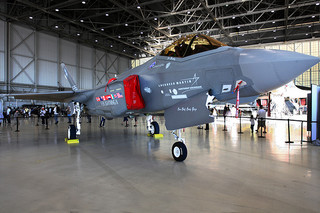Even its mainstream media supporters at Postmedia News, and CTVglobemedia are now angry with the Harper Conservatives for concealing the true costs of the F-35 fighter jet.
The Harper government denounced the Parliamentary Budget Officer (PBO) for claiming in March 2011 that F-35 fighter jet costs were about $10 billion more than announced by the Conservatives. Media are swarming now because the Auditor General revealed last week that increased costs — similar to what the PBO reported — were known within the government, which chose not to share the information with parliament, or the public.
Catching the government with its pants down is certainly news. Note that it was the Auditor General, the PBO and the opposition parties that drew the media’s attention to what had been known in Canada, and major news in the U.S. Cost over-runs, and mismanagement of the F-35 file were well covered in mainstream U.S. reporting on military issues.
The important questions remain unanswered. Why does Canada need to pay $29 billion or more for first-strike jet aircraft? Who do we intend to attack with our 65 F-35 fighters? Why would these target countries be considered a threat to Canada? A report by the Rideau Institute in 2010 questioned why Canada needed to acquire the F-35 received press attention at the time, but the issues it raised are still without a coherent response.
U.S. Defense Secretary Leon Panetta, speaking in Ottawa last March 28, described the U.S. as “100 per cent committed” to development of the F-35 first-strike jet aircraft, saying it is “part of the defence strategy the United States went through and has put in place.” As a junior partner to the U.S., Canada is preparing to go along, without asking too many questions about what it all means.
The new U.S. defence policy has been described as the Asia pivot, with the U.S. re-balancing its military forces and creating a so-called “ring of fire” around China. The fear that China represents a threat to U.S. global hegemony is thought by the Chinese to be behind the Asia pivot, announced by President Obama in a November 2011 speech to APEC.
Stephen Harper has discovered China as a market for Canadian bitumen. To get it to market, Harper wants the Northern Gateway pipeline built across the Great Bear rainforest, from Alberta to Kitimat on the B.C. coast, with as little delay as possible, and without the financial interference of “foreign” environmental groups.
So, which is it? Is China a newly discovered Conservative trading opportunity, or a threat to be countered by acquiring F-35 jets?
The U.S. F-35 program envisages the purchase of 2,443 planes at a total cost of a projected $1.51 trillion over the planes’ 50-year life cycle. Canada is a level three partner along with Australia, Denmark, Norway and Turkey in the F-35 development program, with the U.K. being the only level one partner.
Canada bought into F-35 development in 1996. Today, the government points to potential industrial benefits for the aerospace sector in Canada as the selling point for the purchase.
Canadian companies are supposed to benefit as a sub-contract supplier of parts and equipment for the F-35. Mimicking the U.S. military industrial complex is apparently enough to justify Conservative policy.
The reality is the U.S. calls all the shots on F-35 development. What part of the sub-contracting Canada gets will in no way compensate for the astronomical costs of acquiring a plane, which no one can explain why we need, other than to say it is what the military wants. If developing the aerospace industry is a policy objective, why not create a public company, and build our own plane? It would certainly be cheaper, more suited to Canadian needs and is doable under the national security exemption from NAFTA rules.
Not questioning the military and excessive spending on national security were hallmarks of the 1980s Ronald Reagan era, when the contradictory neo-conservative ideology of limited government and planned military expansion took hold in Canada as well as the U.S.
That contradiction was never so apparent as when the Harper Conservative Government spent millions of public dollars advertising its economic action plan in the run-up to the 2011 election, all the while denying that governments could plan or act, and claiming that the economy could fix itself.
The 2011 election was precipitated when Liberal Leader Michael Ignatieff introduced a non-confidence motion, after a preliminary ruling from the Speaker of the House of Commons found the Conservatives were in contempt of parliament for not revealing the cost of F-35 jets, and the war on crime.
The unfortunate Liberal leader thought the media would take the money wasting seriously, that Canadians would turn against Harper, and that the government would subsequently be defeated. He was wrong on all counts.
The Conservative party had been busy destroying Igantieff’s reputation through vicious television attack ads that had run since his selection for the post. In 2011, Conservative government advertising of its phony economic action plan, and party advertising demonizing Iganatieff combined to overwhelm any media reporting of Conservative wasteful spending on the F-35. As a result, the Conservatives received enough support in English Canada to outpace the Liberals and the NDP. In Quebec, where there is a well-developed media culture, the Conservatives lost one-half of their 10 seats.
An open democratic society depends on independent media reporting. In English Canada advertising overwhelms journalism, and we all pay the costs, including for the over-priced, unnecessary, F-35 fighters.
Duncan Cameron is the president of rabble.ca and writes a weekly column on politics and current affairs.



